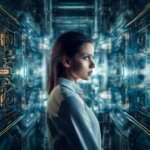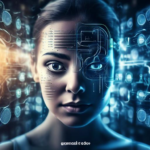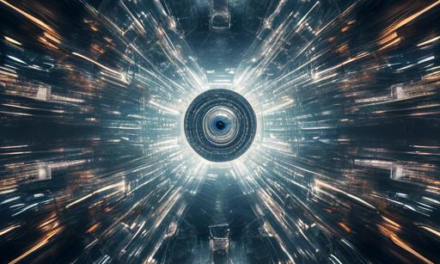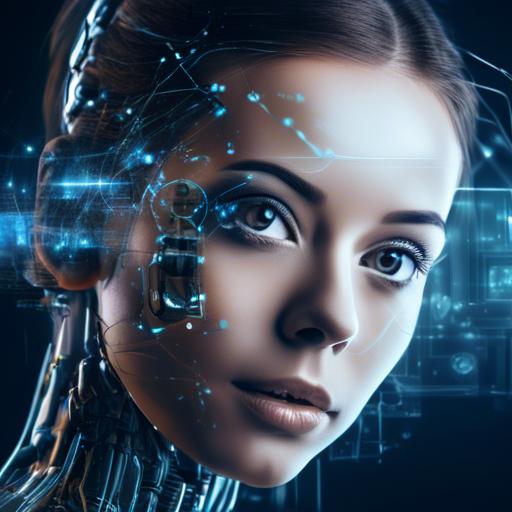In a world where every pixel counts and visual storytelling reigns supreme, the evolution of image quality has emerged as a silent yet powerful force shaping our daily experiences. Once the realm of expert photographers and intricate technologies, the enhancement of images now dances to the rhythm of artificial intelligence, revolutionizing how we see, capture, and share our visual world. Imagine a lens that not only captures reality but can elevate it, transforming mundane snapshots into breathtaking masterpieces with the mere flicker of an algorithmic brush. As we journey through the awe-inspiring intersection of art and technology, let’s delve into the fascinating role of AI in taking our visual narratives from ordinary to extraordinary, redefining not just what we see, but how we feel. Together, we’ll explore how this digital sorcerer is coloring the future of imagery with precision, creativity, and a touch of magic.
Transforming Pixels to Perfection: The AI Advantage
![]()
With the advancements in AI technology, the realm of image enhancement has undergone a revolutionary transformation. Imagine turning a grainy, lackluster photo into a work of art. This has become a reality thanks to sophisticated algorithms and deep learning models that meticulously analyze and enhance images down to the individual pixel.
AI-driven tools employ multiple techniques to achieve crystal-clear results. Some of the most impactful methods include:
- **Super-Resolution**: Enhancing the resolution of an image without losing details or introducing artifacts.
- **Noise Reduction**: Eliminating graininess while preserving essential details.
- **Color Correction**: Balancing color tones for a natural, vibrant look.
- **Image Restoration**: Recovering lost details in degraded or old photographs.
- **Face Optimization**: Automatically detect and refine facial features for stunning portraits.
Let’s break down some of these processes with an illustrative comparison:
| Technique | Before | After |
|---|---|---|
| Super-Resolution | Grainy and pixelated | Sharp and detailed |
| Noise Reduction | Lots of digital noise | Clean and smooth |
| Color Correction | Faded colors | Vibrant and balanced |
AI doesn’t just improve the aesthetics; it’s a time-saver for professional photographers and graphic designers. Tasks that previously took hours can now be completed in minutes, freeing up creative professionals to focus on what they do best: creating and innovating.
This emerging technology also democratizes high-quality image enhancements. **Even casual users** can now achieve near-professional results with minimal effort, thanks to user-friendly applications powered by AI. It’s clear that the influence of AI in image quality enhancement is both profound and far-reaching, changing the way we capture and perceive visual content.
Deep Learning Techniques in Image Enhancement
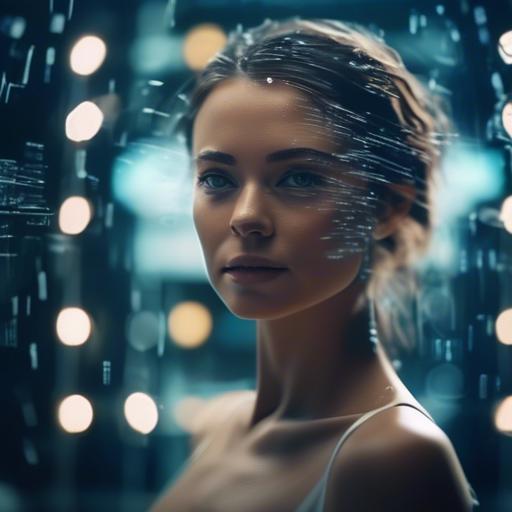
Deep learning has revolutionized the realm of image enhancement, transforming previously tedious and complex processes into efficient and automated solutions. Utilizing sophisticated neural network architectures, modern AI systems significantly improve image quality by addressing various aspects such as noise reduction, resolution enhancement, and color correction. These advancements have found applications in diverse sectors including medical imaging, remote sensing, and digital photography.
One of the key techniques in this domain is Convolutional Neural Networks (CNNs). CNNs excel in feature extraction, allowing them to effectively enhance details and structures in images. Through multi-layer processing, these networks can identify intricate patterns and textures, thus refining image quality in almost every dimension. Innovations in architectures like ResNet and GANs (Generative Adversarial Networks) have further amplified the potential of CNNs, pushing the boundaries of what’s possible in image enhancement.
Below are some remarkable features enabled by deep learning in image enhancement:
- Super-Resolution: Generates high-resolution images from low-resolution inputs, making it possible to restore old or damaged pictures.
- Denoising: Removes noise from images without sacrificing important details, leading to clearer and cleaner visuals.
- Colorization: Converts grayscale images to color with impressive accuracy and vividness.
- Style Transfer: Alters the style of an image based on the features of another image, enabling artistic transformations.
Here’s a quick comparison of traditional vs. deep learning techniques for some of the most common image enhancement tasks:
| Task | Traditional Techniques | Deep Learning Techniques |
|---|---|---|
| Super-Resolution | Interpolation | Convolutional Neural Networks |
| Denoising | Gaussian Filters | Autoencoders |
| Colorization | Manual Tinting | Generative Adversarial Networks |
Advancements in deep learning not only contribute to better image quality but also streamline workflows by automating intricate enhancement processes. This has massive implications for industries reliant on high-quality imaging, minimizing the need for manual intervention and enabling significant time savings. The integration of AI technology in image enhancement sets a new standard, making high-fidelity visuals more accessible across various fields.
Improving Low-Light Photography: AI to the Rescue
When it comes to capturing moments in dim settings, the struggle is real. However, with the advent of artificial intelligence, photographers of all skill levels can now achieve stunning low-light images. AI technologies are making significant strides in improving image quality, especially when natural lighting is less than ideal.
A key advantage of AI in this context is its ability to **reduce noise** without sacrificing detail. Traditional noise reduction techniques often blur the image, but AI algorithms are smart enough to differentiate between noise and actual image data. This means you get to keep the fine details that make your photograph special. Additionally, many AI-powered apps provide customizable settings, allowing you to balance noise reduction and detail preservation according to your preference.
- **Automatic Exposure Adjustment**: AI can adjust exposure levels on-the-fly, ensuring that your photos aren’t too dark or too bright.
- **Smart Color Correction**: These algorithms can accurately reproduce colors, even in poor lighting conditions.
- **Detail Enhancement**: Enhance textures and fine details that would otherwise be lost in low light.
Have you ever taken a photo in a dark room only to find it filled with motion blur? AI can help with that too. Advanced motion stabilization techniques employ machine learning models to analyze and correct for movement, yielding clear, sharp images even when your hand isn’t perfectly steady.
Consider the ultra-thin margin for error with nighttime photography. Traditional cameras often struggle with autofocus in low light, but modern AI systems excel here. These systems can instantly evaluate multiple points in the frame to find the subject and deliver sharp focus with amazing precision. It’s like having a seasoned photographer within your device, guiding your every click.
| Feature | Traditional Method | AI-Powered Solution |
|---|---|---|
| Noise Reduction | Blurs Image | Preserves Detail |
| Exposure Adjustment | Manual | Automatic |
| Motion Blur | Common Issue | Minimized |
| Autofocus | Inconsistent | Highly Accurate |
AI is transforming the realm of low-light photography from a realm of compromise to a canvas of endless possibilities. So next time you find yourself frustrated with subpar lighting, remember: your device’s AI is there to help you capture the moment in all its intended brilliance.
Harnessing Neural Networks for Sharper Images
Deep learning has revolutionized the way we perceive and enhance images. At the heart of this transformation lie neural networks, which have the remarkable ability to learn and identify intricate patterns within visual data. These networks excel at recognizing details that might elude even the most discerning human eyes, resulting in significantly sharper and crisper images.
One of the most striking developments in this space is **convolutional neural networks (CNNs)**. By mimicking the human visual processing system, CNNs can fundamentally alter image quality. Here are some key techniques:
- Super-Resolution: Enhancing image resolution far beyond the original capacity by predicting high-frequency details.
- Image Denoising: Removing unwanted noise while preserving essential details, resulting in clearer outputs.
- Image Restoration: Correcting distortions and improving the overall appearance of an image.
Let’s delve deeper into how neural networks contribute to image restoration through a basic comparison:
| Aspect | Traditional Methods | Neural Networks |
|---|---|---|
| Accuracy | Moderate | High |
| Flexibility | Rigid | Adaptable |
| Processing Time | High | Low |
By leveraging these advantages, neural networks offer a potent solution for any application requiring impeccable image quality. This includes medical imaging, satellite imagery, and even everyday photography. The adaptability and precision of these networks ensure that every pixel is adjusted to contribute to the overall clarity of the final image.
In essence, neural networks are the silent guardians of image quality, perpetually at work to refine and perfect visual content. As these technologies continue to mature, we can anticipate even more groundbreaking enhancements, making the once impossible feats of image enhancement not just possible, but commonplace.
Color Correction and AI: A Symbiotic Relationship
The powerful fusion of color correction techniques and AI innovations forms an indispensable alliance in the realm of image quality enhancement. Deep learning algorithms have revolutionized the way color accuracy and vibrancy are optimized, allowing photographers, designers, and content creators to bring their visions to life with unprecedented precision. AI-driven color correction tools can swiftly analyze an image’s color palette, correcting slight imbalances and enhancing hues in a manner that replicates the nuanced touch of a professional.
**AI capabilities in color correction include:**
- Analyzing the tonal range of an image to adjust brightness and contrast
- Identifying and rectifying color casts to achieve true-to-life colors
- Leveraging machine learning to match color grades to consistent styles
- Enhancing dynamic range while maintaining natural look
Imagine an image editing workflow where AI intuitively understands the artistic intent behind each photograph. Tools equipped with advanced AI technology can recommend optimal color schemes and adjustments, guiding users towards achieving their desired aesthetic with ease. This intuitive approach takes the guesswork out of post-processing, offering real-time feedback and illustrative previews. Users are empowered to make informed choices, supported by data-driven insights and analysis.
For content creators, seamless integration of AI in color correction means not only faster turnaround times but also a more consistent output across different projects. AI refines every detail, ensuring uniformity in tone and quality—crucial for brand identity and visual storytelling.
| AI Application | Benefit |
|---|---|
| Automated Color Matching | Ensures consistency across all images |
| Real-time Adjustments | Instant feedback and minimal processing time |
| Dynamic Range Enhancement | Balanced exposure with details preserved |
As AI continues to evolve, its role in transforming image quality through innovative color correction techniques will only grow stronger. This symbiotic relationship ensures that technology and creativity coexist harmoniously, enabling visual artists to push the boundaries of their craft without forsaking quality or efficiency.
AI-Powered Noise Reduction: A Clear Path Forward
AI technology has brought a transformative shift in how we approach noise reduction in digital images. **Traditional methods** often rely on filters that may blur some details. In contrast, AI leverages complex algorithms to identify and eliminate noise without compromising the integrity of the true image. This results in sharper, clearer visuals that reveal the fine details and textures which would otherwise be obscured.
Imagine capturing a nighttime cityscape with all its bustling vibrancy, only to find the photo filled with unattractive grain. With AI-powered noise reduction, such an image can be processed to maintain the **intricate elements** like the shimmer of streetlights and the reflection in wet pavements, creating a stunning, high-quality picture.
| Traditional Methods | AI-Powered Noise Reduction |
|---|---|
| Blurs finer details | Preserves image fidelity |
| Limited noise identification | Context-aware noise suppression |
**Content creators** and **photographers** are embracing this revolution. They no longer need to spend hours manually tweaking each photo. AI algorithms can process batches of images swiftly and efficiently, ensuring consistent quality across entire galleries. This not only saves time but also ensures that creative professionals can maintain their unique aesthetic without any unwelcome distractions.
Beyond individual use, businesses benefit enormously from AI-driven noise reduction. High-quality images are essential for marketing materials, websites, and social media presence. By leveraging AI, companies can produce professional-grade visuals in a fraction of the time, allowing them to focus on their core operations and growth. It’s an investment in **brand reputation** and customer engagement that pays dividends in consistency and appeal.
Real-Time Image Enhancement: The Future is Now
Imagine snapping a photo in low light, only to find it just as vibrant and clear as if the room were fully lit. This isn’t science fiction—it’s the magic of AI-driven real-time image enhancement, transforming bland pictures into visually captivating masterpieces. Every pixel is taken into a transformative journey, resulting in images rich in color, sharpness, and clarity.
Several advanced **AI algorithms** come into play in this process:
- **Noise Reduction Algorithms:** Minimize visual distortions and granularity.
- **Color Correction Models:** Maintain natural and vivid color tones.
- **Edge Detection and Optimization:** Sharpen the edges to keep the details intact.
- **Super-Resolution:** Enhance the image resolution beyond its native capability.
For a clearer perspective, let’s explore the common benefits brought by these AI enhancements:
| Aspect | Traditional Image | AI-enhanced Image |
|---|---|---|
| Clarity | Blurry | Sharp |
| Color Accuracy | Faded | Vivid |
| Noise Level | High | Low |
Furthermore, real-time processing is all about speed without compromising quality. In video applications, this means **live streaming** with enhanced quality, turning low-bandwidth feeds into high-definition experiences, which is revolutionary for platforms relying on visual content, from social media to professional broadcasting.
Adaptation is the spotlight feature here. AI doesn’t just apply a one-size-fits-all filter; it intelligently adapts to the unique characteristics of each image. Whether it’s highlighting the intricacies of shadow in a portrait or preserving the dynamic spectrum of a sunset, AI brings out the best in every scenario.
It’s exciting to see how **AI-powered tools** continue to advance the frontiers of digital photography and videography. With the rise of real-time capabilities, the future is indeed brimming with enhanced imaging possibilities, promising to make every captured moment as memorable and vivid as possible.
Balancing Resources and Quality with AI
Artificial Intelligence (AI) has revolutionized the way we approach image quality, making it easier for creators to maintain a delicate balance between resource allocation and the final output. Traditionally, enhancing image quality would involve extensive manual labor. However, AI now offers a plethora of tools to **optimize image processing**, empowering artists and designers to meet high standards without compromising on their resources.
One of the key benefits AI brings to the table is the ability to automate various stages of image enhancement. This includes tasks like **noise reduction**, **color correction**, and **sharpness optimization**. By utilizing AI algorithms, software can now independently analyze images, identify imperfections, and apply suitable corrections, all while significantly reducing the time and effort needed from human operators.
- Noise Reduction: AI reduces background noise while preserving essential details.
- Color Correction: Ensures accurate and vibrant colors in every frame.
- Sharpness Optimization: Enhances details without introducing artifacts.
Moreover, AI systems are continuously **learning and evolving**, allowing them to adapt to new challenges and improve their performance over time. These smart algorithms are designed to handle complex tasks more efficiently, making them a valuable asset in resource management. As AI continues to improve, the gap between high-quality images and time-consuming edits shrinks, enabling creators to focus on their artistic vision rather than technical constraints.
| Task | Traditional Time | AI Time |
|---|---|---|
| Noise Reduction | 30 minutes | 5 minutes |
| Color Correction | 40 minutes | 8 minutes |
| Sharpness Optimization | 45 minutes | 10 minutes |
Besides improving efficiency, AI tools also contribute to **sustainable resource usage**. They minimize the need for high-end hardware and reduce electricity consumption by performing complex computations quickly and efficiently. This is particularly valuable for small businesses and independent creators who may have limited resources but aim to produce top-tier work.
Empowering Creatives: AI Tools for Image Enhancement
In today’s digital landscape, creatives are constantly seeking ways to improve the quality of their visuals. Artificial Intelligence (AI) has emerged as a game-changer, offering tools that significantly enhance image quality. These tools are not just for professionals; they are accessible to anyone looking to refine their work, offering functionalities that were once the reserve of the most advanced editing software.
AI-driven applications provide powerful features such as:
- Auto Image Cropping: Intelligent cropping techniques that focus on the main subject of the image.
- Noise Reduction: Minimize unwanted graininess while preserving detail.
- Color Correction: Adjust colors with precision for a naturally balanced look.
- Upscaling: Enhance resolution without losing quality, making images crisper and more detailed.
Consider the practicality of some popular AI tools for image enhancement:
| Tool | Feature | Benefit |
|---|---|---|
| Adobe Photoshop | AI-Powered Filters | Quick and sophisticated edits |
| Canva | Background Remover | Simplifies image isolation |
| Deep Image | Image Upscaler | Boosts resolution smoothly |
These tools extend beyond basic enhancements, fostering a richer creative process. With capabilities such as **content-aware fills** and **dynamic sky replacements**, AI helps generate imaginative and professional results quickly and efficiently. Moreover, the evolution of **AI algorithms** ensures that these tools are continuously improving, offering ever better results with each iteration.
For creatives, this means less time spent on manual corrections and more freedom to focus on the artistic aspects of their work. The fusion of human creativity and machine precision opens up new horizons, not only in enhancing the quality of images but also in redefining what’s possible in digital artistry.
In Conclusion
the advancements in AI technology have truly revolutionized the way we enhance image quality. With AI algorithms constantly learning and improving, we can expect even more groundbreaking developments in the future. So, let’s embrace the power of AI and continue to push the boundaries of what is possible in the world of photography and image processing. Let’s unlock the full potential of our creativity and let AI be our partner in creating stunning visuals that captivate and inspire. The future is bright, and AI is leading the way towards a new era of image enhancement. Let’s harness this power and elevate our art to new heights. The possibilities are endless, and the journey is just beginning. Let’s dive in and explore the amazing world of AI-driven image enhancement together!





